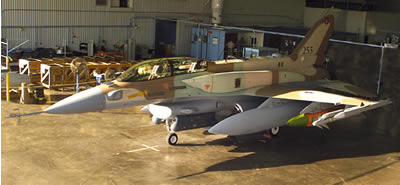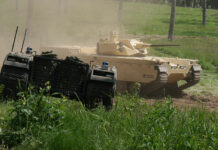The Israeli F-16I, also known as Sufa (Storm) is Powered by the Pratt and Whitney F100-PE-229 Improved Performance Engine. The aircraft is designed for gross takeoff gross weight of 52,000 lbs, the most ever for an Israeli F-16. It incorporates a dorsal equipment compartment and a fully missionized rear cockpit. Along with hosting the latest in electronic countermeasures equipment, the F-16I will be compatible with a wide variety of stores including day/night navigation and targeting pods, advanced air-to-air missiles, and precision “smart” weapons. By February 2004, the Israel Air Force (IAF) is expected to receive the first F-16Is. the initial delivery is a part of 102 aircraft under the Peace Marble V program, expected to be delivered at a rate of two per month, over four years, the largest Israeli acquisition yet. This acquisition raises the total number of IAF F-16s to 362, which will make the IAF the one of the world’s largest F-16 operators, second only to the US Air Force.
The F-16I will provide the backbone of the air force’s strike force, and is expected to gradually phase out the last of the F-4E/2000 units that are still operational with the IAF, although, according to senior IAF officials, such decision has not been taken yet. The new aircraft will augment more than 230 F-16s now in service, as well as the IAF’s fleet of more than 90 F-15-series fighters. The IAF received its first 75 F-16A/Bs (blocks 5, 10 and 15, designated “Netz”) in 1980-1981. In 1987-1988, Israel received 75 Block 30 F-16C/D aircraft (designated Barak). 60 Block 40 (Barak-2) aircraft were delivered in 1990-1993. In 1994, 50 USAF surplus Block 10 aircraft were delivered to augment existing units and replace attrition. These aircraft were modernized to the IAF Netz standard, and are now designated Netz-2.
The current delivery of 102 aircraft will be the last major reorganization of the IAF, until the acquisition of the next generation fighters (such as JSF). The aircraft are expected to be fielded in several bases in the Negev desert, initially in the Ramon Air Force Base. The IAF plans to implement a new logistical support system in one of the Negev bases, to optimize the use of support equipment, test systems, spare parts and manpower skills. Another aspect of the support concept is the training of “versatile technicians”, support personnel who have more than one skill, hence fewer but more versatile support teams will be able to support the aircraft at more effective turnaround cycle.




















